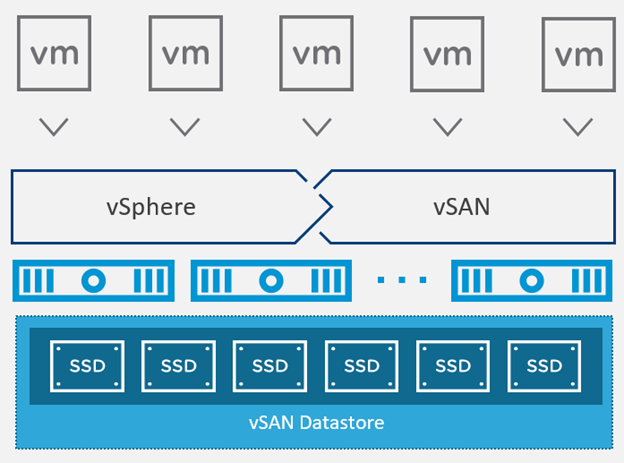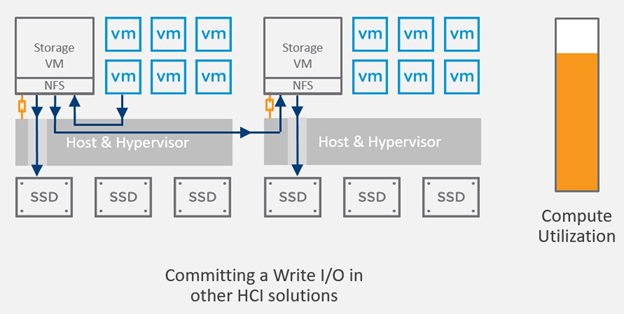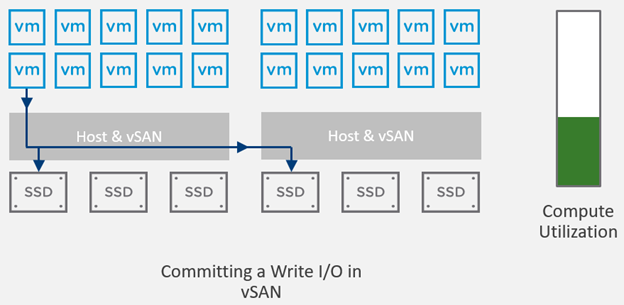I find myself having more and more conversations around SDS and HCI every day but it surprises me how many people don’t understand the fundamentals of what vSAN is and how it is different from other “Software defined storage” offerings out there. Here I will outline some of the differences between vSAN and a storage VM, as well as go over some of the basics and deployment options for vSAN.
First things first, what is vSAN? vSAN is VMware’s software-defined storage solution, built from the ground up for vSphere virtual machines. It abstracts and aggregates locally attached disks in a vSphere cluster to create a storage solution that can be provisioned and managed from vCenter and the vSphere Web Client. vSAN is hypervisor-converged – that is – storage and compute for VMs are delivered from the same x86 server platform running the hypervisor. It integrates with the entire VMware stack, including features like vMotion, HA, DRS etc. VM storage provisioning and day-to-day management of storage SLAs can be all be controlled through VM-level policies that can be set and modified on-the-fly. vSAN delivers enterprise-class features, scale and performance, making it the ideal storage platform for VMs. Some key things to remember about vSAN in summary would be:
• Runs on any standard x86 server
• Integrated into hypervisor
• Pools HDD/SDD into single cluster-wide shared datastore
• Easily scalable
• Managed through VM storage policies
I have said this before but not all HCI solutions are created equal. How an hyper-converged solution is implemented matters. Some solutions provide an HCI solution using a Virtual Appliance pinned to each host in a cluster to provide storage services. But this comes at a significant cost to the user, as the number of effective VMs per host will be significantly reduced, and the performance of the VMs will be more inconsistent. Some of the problems that come with this would be:
- Resource-intensive storage controller VMs on every host
- More hops, context switching, queues, and locks
- Host CPU and I/O amplification
- Fewer VMs per host, with less consistent performance
- Unaware of hypervisor activities
The efficiency in delivering storage is one of the true secrets behind the power of vSAN. This tremendous efficiency means that vSAN can run more VMs per host than any other HCI system not integrated into the hypervisor. And not only that, but do with much more consistent levels of performance. This ability to scale up and out means that users can strategically design their vSAN powered cluster to accommodate growth that best reflects the needs of their organization.
VMware vSAN takes advantage of being integrated directly into the kernel to offer supreme levels of efficiency, performance, and integration. This translates into a significant increase in the number of VMs per host as compared to virtual appliance based HCI solutions, with better, more consistent performance. Since vSAN is integrated into the hypervisor, it is aware of all of the hypervisor aware activities, and understanding of cluster topologies. This drives down the operational complexity, and is easy to adopt into an organization because it is software the user already knows. This provides the users with the benefits of:
- vSAN embedded into vSphere
- Simplified, most efficient I/O path
- Minimal Host CPU and I/O overhead
- More VMs per host, with more consistent performance
- Awareness of hypervisor activities

The way that vSAN is delivered to a customer is dependent on whatever suites their needs best. This is why the power of choice is so important. Some want to simplify purchasing, deployment, and management with single SKUs, and is where VxRail comes into play. Others may have a preference of server vendor, and would like to maintain that consistency as they adopt vSAN. This is where vSAN ReadyNodes can be a great option. While others may want to build their own server configurations off of certified components. These three consumption offer a great set of choices that fit the needs of the organization in the best way possible. Three consumption models for vSAN are:
- Turn key Dell EMC VxRail appliances
- Certified ReadyNode configurations by 15 server vendors
- Build your own configurations in accordance to VMware’s Compatibility Guide

In conclusion, vSAN has come a long way in the past few years. I remember I originally posted about it back in 2014 when it was first introduced and at that time, I was not a huge fan. It has come a LONG way since then and I have really started to love it. I think SDS (Software Defined Storage) is going to shake up the IT industry just as much as VMware changed the game back when they first introduced the idea of a Hypervisor. I will be posting more frequently about some of the updates in SDS and HCI so stay tuned for more.